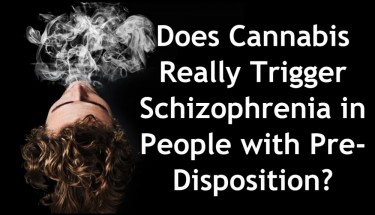
In recent times, mental health conditions like schizophrenia have become a go-to scapegoat for those pushing for tighter cannabis regulations. Proponents of stricter rules often lean on personal stories and anecdotal evidence to make their case, advocating for things like THC caps or limits on how much cannabis people can buy. On the surface, these restrictions might seem like a reasonable way to protect public health. But when you dig a little deeper, you'll see that they're actually a sneaky attempt to limit our choices and freedoms when it comes to legal cannabis use.
Now, let's talk about the supposed link between schizophrenia and cannabis. Time and time again, researchers have tried to pin down a causal relationship between the two. But guess what? In pretty much every study published on the subject, they've only managed to come up with correlational data – no smoking gun that proves one causes the other. This gray area leaves plenty of room for misinformation and manipulation, allowing those who favor stricter cannabis laws to exploit people's fears about mental health disorders.
So, let's dive into a recent article that tells the heart-wrenching tale of Cat Mayberry, a young woman who battled schizophrenia and eventually lost her life after struggling with cannabis addiction- at least according to her parents.
Through this story, we want to expose the tactics used to control the narrative around drug legalization and show why basing policy decisions on emotion-driven anecdotes isn't the best approach.
By taking a closer look at the information in the article, we hope to spark a more well-rounded, evidence-based conversation about the intricate relationship between cannabis and mental health.
Now, I want to make it clear that I don’t stand in opposition of the Mayberry’s. What they experienced is horrific. The loss of a child is something that will break a person.
Therefore, I share their idea of increasing awareness, education, etc – but I believe it should be expanded to mental health in general.
We’ll explore how Schizophrenia works, and unpack different perspectives to get a nuanced view on this subject. I’ll remain respectful of the life of Catherine since I believe that this is an important topic, and that should be taken with the utmost care.
The Story of Cat
Before we dive into a deeper analysis, let's first summarize the article in question, which tells the story of Cat Mayberry, a young woman who struggled with schizophrenia and addiction. This is a brief overview of Cat's life, her transformation, and her parents' accounts, featuring direct quotes from the article.
Cat Mayberry had been diagnosed with ADHD since an early age, and her parents, Trent and Jane, claim that she was a typical teenager. It wasn't until college that things took a dark turn. In her freshman year, she began smoking cannabis, which her parents believe triggered her schizophrenia. Cat's mental health rapidly deteriorated, and she was soon admitted to inpatient care for her condition.
According to her parents, the antipsychotic medications did not improve Cat's mental health but made her feel numb and gain weight. Throughout her struggle with schizophrenia, Cat also continued to use marijuana. Her parents recalled that at one point, she would walk around with headphones on, playing music loudly to try to drown out the voices in her head. "That one she played over and over and over," Jane said.
Cat went in and out of inpatient and outpatient care, and her parents eventually got her placed in supportive housing for people with severe mental illness. However, she had lost her old friends and developed an interest in body art, including getting piercings and tattoos. While living at Rising Cedar, the best supportive-housing facility in the Twin Cities, Cat was introduced to methamphetamine.
Her parents found her in an alley living in a tent with a homeless person after she mistakenly believed she had been kicked out of her apartment. Trent and Jane came to the devastating realization that their daughter's life would never return to normal. As Trent put it, "Her brain was ruined at this point. We sensed it."
Tragically, Cat was found dead at the age of 24, with a glass pipe and a packet of meth laced with fentanyl nearby. Her father, Trent, said, "I look at it as, God answered our prayers. We knew it was going to happen. It was just a matter of time. It happened at a point where our family was as strong as it could possibly be."
Cat's story has become a rallying cry for proponents of stricter cannabis regulations, as her parents believe that her marijuana use was the primary cause of her mental health issues. Trent said, "People can say, yeah, she died from a fentanyl overdose, but that's not what really killed her. That's what killed Cat. That's not what killed Catherine. Catherine was killed by cannabis."
This is the major sentiment from the article. The rest of the article provides “supporting evidence” in the form of studies, but as you’ll see later – these may not be the main area of concern.
Let’s begin breaking down what’s wrong with this perspective and how we can have a better approach to drug policy that will attempt to reduce the impact of addictive personalities, mental disorders, and how we as society deal with these issues.
Prohibition simply doesn’t work
Prohibition has been a historically ineffective method of regulating substances, and this holds true for cannabis as well.
As the tragic story of Cat Mayberry demonstrates, the answer to addressing cannabis-related issues is not through prohibition, but rather through education and understanding the risks associated with its use.
Even Cat's parents recognize that prohibition was not the root of their daughter's struggles, but rather a lack of education and awareness about the potential risks of using cannabis.
It's crucial to remember that just like any other substance, cannabis can have different effects on individuals based on their unique biological makeup. For those with a predisposition to schizophrenia or other mental health issues, using high-potency cannabis products may exacerbate their conditions.
However, it's unfair and unreasonable to limit the choices and rights of those who do not have such predispositions and can use cannabis products responsibly without negative consequences.
One possible approach to addressing this issue is to implement screening measures from a young age, which would help identify individuals who may be more susceptible to developing mental health issues when using cannabis. By doing so, families and individuals can be better prepared to navigate potential risks and make informed decisions about whether or not to use cannabis products.
Moreover, exploring alternative treatments for mental health conditions like schizophrenia can also contribute to a more comprehensive and compassionate approach to managing these issues.
For instance, holotropic breathwork, a technique that involves controlled breathing patterns, has shown promising results in helping individuals with schizophrenia (Garcia-Romeu, A., & Richards, W. A. (2017).
Current perspectives on psychedelic therapy: use of serotonergic hallucinogens in clinical interventions. International Review of Psychiatry, 29(4), 331-341.). This method, along with other evidence-based treatments, could offer additional options for individuals struggling with mental health conditions, reducing the reliance on substances like cannabis as a coping mechanism.
It's essential to acknowledge the complex relationship between cannabis use and mental health issues, and to approach this topic with nuance and empathy.
Rather than resorting to heavy-handed prohibition or restrictive regulation, we must focus on empowering individuals with the information and resources they need to make responsible choices about their cannabis use.
This includes increasing awareness about the potential risks associated with high-potency cannabis products for those predisposed to mental health issues, and supporting the development of alternative treatment options for those who need them.
What about Pharma?
The use of ADHD medications, particularly in children and adolescents, has been a topic of ongoing debate in the medical community. While these drugs have been proven to be effective in managing the symptoms of ADHD, there is still much to learn about the long-term effects of these medications on brain development. It's worth noting that the conversation around the potential risks of these drugs is often overshadowed by the more prominent discussions surrounding cannabis.
ADHD medications, such as methylphenidate (Ritalin) and amphetamine (Adderall), are stimulants that work by increasing the levels of certain neurotransmitters in the brain. While these drugs can help improve focus and reduce impulsivity in individuals with ADHD, there are concerns about the potential impact of these medications on the developing brain.
A study by Andersen, S. L. (2005) published in the journal Neuropharmacology, raises concerns about the long-term consequences of using stimulant medications during critical periods of brain development. The study suggests that early exposure to these drugs may lead to alterations in the brain's dopamine system, which could have implications for future vulnerability to substance abuse and other mental health issues. However, more research is needed to fully understand the implications of these findings.
Another area of concern is the potential link between ADHD medications and the development of schizophrenia or other psychotic disorders. A study by Moran, L. V., Ongur, D., Hsu, J., & Castro, V. M. (2019) published in JAMA Psychiatry found that amphetamines (such as Adderall) were associated with a higher risk of psychosis compared to methylphenidate (Ritalin). While the absolute risk of developing psychosis was still relatively low, the findings underscore the importance of carefully considering the potential risks and benefits of these medications when prescribing them to young patients.
Common side effects of ADHD medications include appetite suppression, sleep disturbances, headaches, and increased heart rate. These side effects can be concerning, especially when one considers that these drugs are being prescribed to children and adolescents whose brains are still developing.
It's worth questioning why pharmaceutical drugs like ADHD medications are often "excluded" from the conversation when it comes to causality in the development of mental health issues, while cannabis takes center stage. Perhaps this is due to the fact that pharmaceutical drugs are heavily regulated and prescribed by medical professionals, whereas cannabis is still a controversial substance that is only recently gaining widespread acceptance for medicinal and recreational use.
Nonetheless, it's essential to recognize that all substances, whether pharmaceutical or recreational, can carry risks and potential side effects, especially for those with pre-existing vulnerabilities or predispositions to mental health issues. A more balanced conversation that acknowledges the potential risks and benefits of all substances is necessary to make informed decisions about their use.
Don’t shift the blame – it’s about Mental illness
Mental illness is a complex and multifaceted issue that requires a comprehensive and nuanced understanding of its various causes and triggers. In cases like Cat's, it's all too easy for parents and society to pin the blame on a single substance, such as cannabis. However, it's crucial to recognize that there are numerous factors that can contribute to the development and progression of mental illnesses like schizophrenia.
Schizophrenia, a severe mental health disorder characterized by delusions, hallucinations, and disorganized thinking, can be triggered by a variety of factors. These include genetic predisposition, environmental factors, brain chemistry imbalances, and substance abuse. Stressful life events, such as the death of a loved one, relationship issues, or the pressures of school and work, can also contribute to the onset of schizophrenia.
It's essential to consider the broader context when examining the role of cannabis in cases like Cat's. The suicide rate among individuals with schizophrenia is significantly higher than in the general population, and many people with the disorder turn to substances as a way of coping with their symptoms. Cat's story, in which her struggles became more apparent during her college years, raises questions about the other potential factors that may have contributed to her mental health decline.
College can be a particularly challenging time for young adults as they navigate academic pressures, form new relationships, and experience a newfound sense of independence. These stressors, combined with a predisposition to mental illness, can act as triggers for the onset of schizophrenia or other psychotic disorders. In Cat's case, it's essential to consider the various factors that may have contributed to her struggles, rather than placing the blame solely on cannabis.
Where the focus should be, as Cat's parents rightly emphasize, is on education. By providing individuals, particularly those at risk, with accurate information about the potential dangers of substance use, we can help them make informed decisions about their consumption. This approach acknowledges the need to protect vulnerable individuals without limiting the choices of those who can safely and responsibly use high-potency cannabis products.
Comparing the situation to the sale of peanut butter, which can be deadly for some people with allergies, offers an interesting perspective. Just as we don't ban peanut butter for everyone because of the risk it poses to a small minority, we shouldn't limit the availability of high-potency cannabis solely based on the potential risks to a specific subset of the population. Instead, we should focus on education and awareness to help those at risk make informed choices about their consumption.
In conclusion, mental illness is a complex issue that cannot be solely attributed to the use of cannabis or any other single factor. It's crucial to examine the various triggers and contributing factors in cases like Cat's, rather than placing the blame on a single substance. By focusing on education and awareness, we can help those at risk make informed decisions about their consumption, without limiting the choices and rights of others who can safely and responsibly use high-potency cannabis products. This approach promotes a more balanced and compassionate understanding of the challenges faced by individuals with mental illness and their families.
MARIJUANA AND SCHIZOPRENIA, READ ON...
DOES CANNABIS CAUSE SCHIZOPHRENIA IN PRE-DISPOSED PEOPLE?







